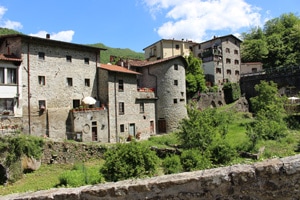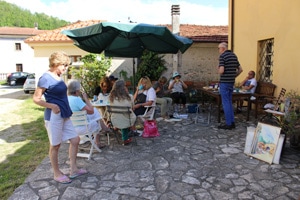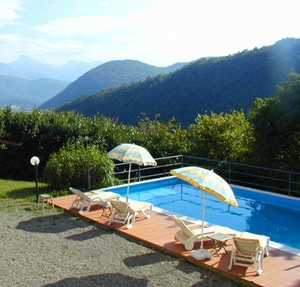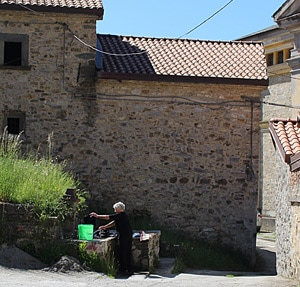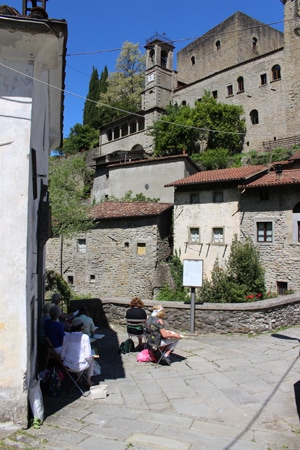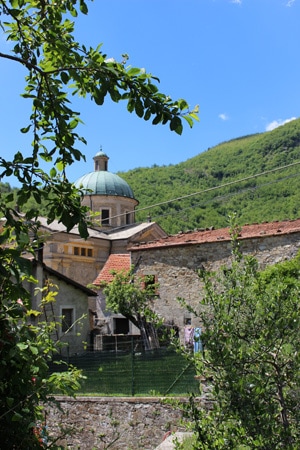|
Tuscany welcomed us with open arms and blue skies. The old village of Cotto, nestling on the slopes of the Apuan Alps gave us all instant inspiration. There is so much choice, that it takes always a bit of time to adjust the painters eye. A short and leisurely stroll did the trick and we chose to make a start just outside the Vecchia Canonica - our home for the painting week. The typical Tuscan front door and huge old wine flagons in their wicker baskets and palms in terracotta pots flanking the entrance to the villa made a perfect composition – and an ideal first demonstration. Beginners were able to learn a few simple rules about drawing for before applying water colours and also concentrate on suitable colours to use to represent the Mediterranean climate. We were blessed again the next day as we made a painting excursion to the impressive medieval castle Verrucola, presently occupied by our friends, the family of the well-known Italian sculptor Pietro Cascella. The setting is particularly exciting because the big bridge over the river at the foot of the castle leads to the small village situated just under it, giving us a perfect foreground motif. This was a great opportunity for me to explain some basic rules for perspective, especially appreciated by the less advanced painters in our group. I was very impressed by the resulting paintings, since even the beginner painters had achieved a good representation of the jumbled roofs, towers and trees by the river. Another bonus point for this attractive location is the little restaurant by the bridge, where we had a delicious lunch. The following day we painted around the village of Cotto with its many old stone farm houses, narrow roads leading up into the terraced hills at various angles. The stunning old church in the centre has almost Duomo like proportions, dwarfing the village and thus making it a irresistible to paint. Though the church has classical proportions and a lot of straight lines to deal with the old farmhouses offered easy subjects like old doors, stone arches leading into barnyards and ruined stone buildings with colourful roofs. These old stone buildings were the perfect subject with which to demonstrate how to create stone texture in watercolour painting. It was also time to practice further the 'wet into wet’ technique, which can make watercolour painting so exciting. This technique is particularly useful for covering large expanses in landscapes or on buildings on the outset of the paintings. Everybody had fun watching the colours 'explode' on the paper. But of course some more controlled brush-strokes were necessary as the watercolour progressed to capture the subject more precisely. After painting for three days, we were ready for our free day in the beautiful city of Lucca. The train journey there through the National Park is wonderful with views towards mountain peaks, villages balancing precariously in hilltops or fringing lakes, while tunnels plunged us into darkness and back into bright sunshine. A day in Lucca is always great fun. Whether you are sketching , shopping or strolling under a canopy of trees along the stunning city walls that have protected the city since the middle ages. Naturally it's also a great place for visiting museums and to admire the white Duomo San Martino amongst other architectural gems. A local ice cream by the main town piazza in the shade of a sun umbrella was a must, since it was a lovely warm day again. On our way home we stopped of three quarters of the way in the village of Monzone, where our lovely bus driver Paulo and his son picked us up after a most enjoyable meal in the local restaurant. Friday approached and we were eager to explore our nearest town, Fivizzano, a few kilometres down the hill. The bus delivered us promptly in the main square by the fountain and our lunchtime restaurant. But before lunch we had to get down to some 'serious' sketching, so we settled in one of the five cafes, or the gelateria. The aim was to sketch local people in a casual loose manner, not necessarily aiming straight away for a likeness, but to captures essential features and gestures. We had a lot of fun, sometimes making contact with people from the town over their coffee or ice ream. After another delicious lunch we went back to Cotto to add watercolour to some of our successful sketches. My demonstration of the simple three colour technique (see also my article in Leisure Painter magazine: link to add!), came in handy and I was able to explain how much can be achieved with just three colours! Inevitably our last day approached and everybody was keen to finish unfinished paintings or get last minute painting tips before going home the next day. One of the 'tricks of the trade' I wanted to pass on was quickly demonstrated by the ancient public laundry troughs - still used by some of the al women of the village women to wash their clothes - where we focused on painting water. There was just enough time after lunch for a session with a very loose and watery panting of the big church with strong and dramatic colours. Later on we had an informal showing of our watercolours in the evening and we very much enjoyed seeing each others favourite paintings from the week. This is always a great pleasure for me, and judging by the happy expressions on everybody’s faces the pleasure was shared by us all. To celebrate a successful week’s painting we set off to a very special restaurant higher up in the mountains in the village of Pieve, where we enjoyed a last meal together, talked shop and laughed a lot. There only remained to give our thanks to our lovely host Karsten who looked after us so well, and to thank everybody on the course for being such enthusiastic painters and great company.
With the best wishes for a summer full of painting, Bettina Comments are closed.
|
Archives
September 2023
|
